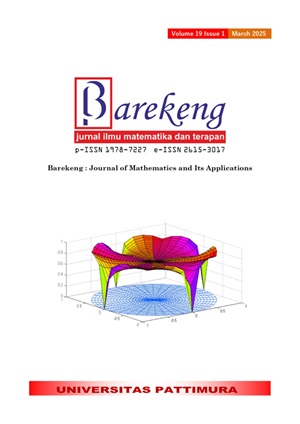A FRACTIONAL-ORDER MATHEMATICAL MODEL OF THE SPREAD OF INFLUENZA
Abstract
Influenza is an infectious disease that has become a public health concern and affects millions of people every year. In Indonesia, 1,527 people were recorded as being infected with influenza from May 2013 to April 2016. In this article, a fractional-order mathematical model of influenza spread was formulated in the sense of Caputo derivative. Based on the model analysis, we obtained two equilibrium points: the disease-free and endemic equilibria. The disease-free equilibrium point is locally asymptotically stable if the basic reproduction number is less than one. Meanwhile, the endemic equilibrium point exists and tends to be asymptotically stable whenever the basic reproduction number is greater than one. Next, a sensitivity analysis was carried out to determine whether changes in parameter values affect the increase or decrease in the value of the basic reproduction number. Lastly, the numerical simulation of the fractional-order model is demonstrated to support the analytical results.
Downloads
References
K. Mostafa, “Fact Sheets Influenza (Seasonal),” https://www.who.int/news-room/fact-sheets/detail/influenza-(seasonal).
D. Gaitonde, F. Moore, and M. Morgan, “Influenza: Diagnosis and Treatment,” Am Fam Physician, vol. 100, no. 12, pp. 751–758, Nov. 2019.
N. K. Susilarini et al., “Estimated Incidence of Influenza-Associated Severe Acute Respiratory Infections in Indonesia, 2013-2016,” Influenza Other Respir Viruses, vol. 12, pp. 81–87, Sep. 2017.
M. M. Ojo, T. O. Benson, O. J. Peter, and E. F. Goufo, “Nonlinear Optimal Control Strategies for a Mathematical Model of COVID-19 and Influenza Co-Infection,” Physics A, vol. 607, pp. 1–27, Sep. 2022.
J. Caldwell and Y. Ram, Mathematical Modelling Concepts and Case Studies. Netherlands: Springer-Verlag, 2013.
N. H. Khanh, “Stability Analysis of an Influenza Virus Model with Disease Resistance,” Journal of the Egyptian Mathematical Society, vol. 24, pp. 193–199, May 2015.
M. Erdem, M. Safan, and C. C. Chavez, “Mathematical Analysis of an SIQR Influenza Model with Imperfect Quarantine,” Society for Mathematical Biology, vol. 79, pp. 1612–1636, Jun. 2017.
C. Kanyiri, K. Mark, and L. Luboobi, “Mathematical Analysis of Influenza: A Dynamics in the Emergence of Drug Resistance,” Comput Math Methods Med, vol. 2018, pp. 1–14, Aug. 2018.
F. S. Rosyada, Widowati, and S. Hariyanto, “Local Stability Analysis of an Influenza Virus Transmission Model Case Study: Tondano Health Center in Pekalongan City,” IOP Publishing, 2018, pp. 1–8.
I. A. Baba, H. Ahmad, M. D. Alsulami, K. M. Abualnaja, and M. Altanji, “A Mathematical Model to Study Resistance and Non-resistance Strains of Influenza,” Results Phys, vol. 26, pp. 1–6, May 2021.
M. Barik, C. Swarup, T. Singh, S. Habbi, and S. Chauhan, “Dynamical Analysis, Optimal Control, and Spatial Pattern in an Influenza Model with Adaptive Immunity in Two Stratified Population,” AIMS Mathematics, vol. 7, pp. 4895–4935, Dec. 2021.
X. Guan, F. Yang, Y. Cai, and W. Wang, “Global Stability of an Influenza: A Mode with Vaccination,” Appl Math Lett, vol. 134, pp. 1–6, Jul. 2022.
Y. Chen, J. Zhang, and Z. Jin, “Optimal Control of an Influenza Model with Mixed Cross-Infection by Age Group,” Math Comput Simul, vol. 206, pp. 410–436, Apr. 2023.
L. C. de Barros, M. M. Lopes, F. S. Pedro, E. Esmi, J. P. C. dos Santos, and D. E. Sanchez, “The Memory Effect on Fractional Calculus: An Application in the Spread of COVID-19,” Computational and Applied Mathematics, vol. 40, no. 72, pp. 1–21, Mar. 2021.
B. Ebenezer, “On Fractional Order Influenza: A Epidemic Model,” Applied and Computational Mathematics, vol. 4, no. 2, pp. 77–82, Mar. 2015.
D. Yaro, W. O. Apeanti, S. W. Akuamoah, and D. Lu, “Analysis and Optimal Control of Fractional-order Transmission of a Respiratory Epidemic Model,” Int J Appl Comput Math, vol. 5, no. 116, pp. 1–21, Jul. 2019.
T. Cui and P. Liu, “Fractional Transmission Analysis of Two Strains of Influenza Dynamics,” Results Phys, vol. 40, pp. 1–15, Jul. 2022.
F. Evirgen, E. Ucar, S. Ucar, and N. Ozdemir, “Modelling Influenza: A Disease Dynamics Under Caputo-Fabrizio Fractional Derivative with Distinct Contact Rates,” Mathematical Modelling and Numerical Simulation with Applications, vol. 3, no. 1, pp. 58–73, Mar. 2023.
M. A. Abdoon, R. Saadeh, M. Berir, F. E. Guma, and M. Ali, “Analysis, Modeling, and Simulation of a Fractional-order Influenza Model,” Alexandria Engineering Journal, vol. 74, pp. 231–240, May 2023.
H. Khan, A. H. Raipar, J. Alzabut, M. Aslam, S. Etemad, and S. Rezapour, “On a Fractal-Fractional Based Modeling for Influenza and Its Analytical Results,” Qual Theory Dyn Syst, vol. 23, no. 70, pp. 1–21, Jan. 2024.
N. E. Alsubaje, F. E. Guma, K. Boulehmi, N. Al-kuleab, and M. Abdoon, “Improving Influenza Epidemiological Models under Caputo Fractional-order Calculus,” Symmetry (Basel), vol. 16, no. 7, pp. 1–18, Jul. 2024.
B. Bandyopadhyay and S. Kamal, Stabilization and Control of Fractional Order Systems: A Sliding Model Approach. India: Springer, 2015.
K. Diethelm, The Analysis of Fractional Differential Equations. New York: Springer-Verlag, 2012.
F. Brauer and C. C. Chavez, Mathematical Model in Population Biology and Epidemiology, Second. New York: Springer-Verlag, 2012.
E. Ahmed, A. M. A. El-sayed, and H. A. A. El-saka, “On Some Routh-Hurwitz Conditions for Fractional Order Differential Equations and Their Applications in Lorenz, Rössler, Chua, dan Chen System,” Phys Lett A, vol. 358, pp. 1–4.
Copyright (c) 2025 Abyan Daffa Akbar, Fatmawati Fatmawati, Ahmadin Ahmadin

This work is licensed under a Creative Commons Attribution-ShareAlike 4.0 International License.
Authors who publish with this Journal agree to the following terms:
- Author retain copyright and grant the journal right of first publication with the work simultaneously licensed under a creative commons attribution license that allow others to share the work within an acknowledgement of the work’s authorship and initial publication of this journal.
- Authors are able to enter into separate, additional contractual arrangement for the non-exclusive distribution of the journal’s published version of the work (e.g. acknowledgement of its initial publication in this journal).
- Authors are permitted and encouraged to post their work online (e.g. in institutional repositories or on their websites) prior to and during the submission process, as it can lead to productive exchanges, as well as earlier and greater citation of published works.






1.gif)



